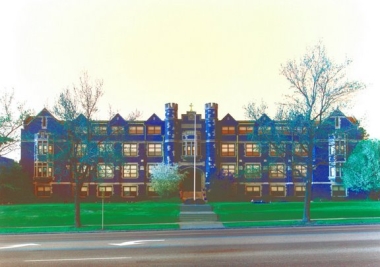In the mid-1990s, the trustees of a small seminary in Oklahoma were faced with a big decision -- should they continue to operate both a small-town campus and a big-city campus, or should they consolidate? A few years later, the board of a large seminary in St. Louis had the opportunity to expand its campus, but at the cost of heavy debt. Should they take on the extra debt in order to give themselves room to grow?
At the same time, the board of a young seminary in Salt Lake City had to make a wrenching decision about how to avoid bankruptcy. Should they sell their campus and become tenants? In each case, decisions about buying and selling property hinged on specific and even unique circumstances. Though these decisions were reflections of financial pressures, they were about more than just money. The decisions required boards to think about the mission of the theological school. Board members grappled with the connection between real estate and education. They faced financial pressures and seized opportunities. They proved themselves flexible in the face of changing circumstances. And they made hard choices.
Selling and staying put
In 2001, Salt Lake Theological Seminary bought a three-story office building on prime real estate in downtown Salt Lake City. The nondenominational, evangelical school, which had outgrown its previous home, planned to occupy part of the building and lease out the rest, covering the cost of the full mortgage with rental income. But according to Jeffrey Silliman, then chair of the board of trustees and currently the seminary's president, things did not work as planned. Managing commercial real estate was more challenging than anyone had expected. Administrators underestimated the cost of operating and maintaining the building, and the school did not use its space efficiently enough.
 |
Jeffrey Silliman, president of Salt Lake Theological Seminary, was board chair when the trustees decided to sell the school's building and lease back part of it. Bankruptcy was not an option, he says.
(Salt Lake Theological Seminary) |
The cost of the building compounded other financial problems, leading to a crisis in early 2005. With no endowment to draw on, and with the seminary's presidency in transition, the board decided that selling the property was essential for survival. Silliman explains that the board did not view bankruptcy as a legitimate option, feeling that it was important for the seminary to "honor its Christian testimony" by paying its bills.
One of the board's decisions was to use a commercial realtor, someone who knew the neighborhood well, rather than relying on someone with ties to the institution. The decision paid off, and the sale was completed in 2007. Throughout the process, the board had hoped to lease back the part of the building it occupied, and indeed the new owner allowed them to do so.
Decisive action on the part of the board helped rescue the school from dire straits, but it still faces financial challenges. Programs and enrollment have grown steadily, but student tuition covers less than 20 percent of the operating budget, meaning that the seminary, like all theological schools, continues to rely on donations from individuals and foundations. Still, the situation today is much brighter than it was in 2005. The proceeds of the sale helped the school pay off much of its debt and restored its financial footing.
Although financial considerations drove the board's decision to sell, there were other factors at work as well. The decision was part of a process of reconceiving the seminary's mission. The board concluded that acting as a landlord, or indeed owning property at all, was no longer necessary or even desirable for the seminary's task of theological education and ministerial formation.
Schools in different circumstances will reach different conclusions about how to manage property, but surely every school benefits from careful consideration of how its property furthers, or hinders, its mission in its particular situation.
Buying and selling
In 2001, Concordia Seminary, a theological school of the Lutheran Church-Missouri Synod located just outside St. Louis, found an opportunity that seemed too good to pass up. A Catholic high school adjacent to the seminary went up for sale, giving the seminary a chance to add more than eight acres and 150,000 square feet of interior space. The property was not cheap--roughly $26 million--so Concordia asked the Marvin M. Schwan Foundation, a Lutheran-related funder, to make the purchase, which it did early in 2002. Two years later, Concordia bought the property from the foundation with the proceeds from a bond issue. It seemed like a tremendous boon.
Concordia's new property quickly proved a financial drain. Many of the buildings were old and required major renovations. Interest on the bond cost $5,000 a day. Compounding these problems, the seminary's funding model had been changing since the 1990s. Denominational subsidies had declined and, though enrollment had increased, tuition payments were covering a smaller and smaller percentage of operating expenses. Faced with stark realities, Dale Meyer, who became the seminary's president in May 2005 after several months as interim president, called in a consultant to study the seminary's space usage.
 |
|
In 2001, Concordia Seminary purchased the campus of a Catholic high school that had moved to a new location. But after a study revealed that the St. Louis seminary wasn't using its existing space efficiently, the newly acquired buildings were sold to nearby Washington University last year.
(Photo courtesy of Concordia Seminary)
|
The consultant discovered that Concordia had plenty of unused space on its old campus, especially given the increasing prominence of distance learning. So Meyer launched a series of focus groups to consider options. These groups, which included faculty, staff, alumni, and construction specialists, met for several months before recommending that the property be sold. The board accepted the recommendation, and in autumn 2007, Concordia sold the property to nearby Washington University.
Facing financial reality allowed Concordia to turn the corner on a difficult situation. The proceeds from the sale mostly covered the bond and helped the seminary regain its financial health. Equally important, however, were the lessons learned. Meyer recalls meeting with a contractor who explained to him that institutions have a natural tendency to buy new property rather than repair what they already own. With this in mind, Meyer began encouraging the seminary to improve its use of its existing space and to put its resources into upgrading the facilities.
One takeaway lesson: Not that schools should avoid buying property, but rather that apparently good opportunities can turn sour. That means the board's responsibility to further the school's mission and ensure its economic health can be deceptively difficult. Sometimes expert advice is needed to help the board make the right decisions.
Selling and moving
For the first eight decades of its existence, Phillips Theological Seminary operated as a graduate school of Phillips University, a Christian Church (Disciples of Christ)-affiliated school in Enid, Oklahoma. In 1987 the university, facing serious financial problems, decided to sell its campus to the city, but that same year, a court ruled that the city could not own a seminary. The result: The university and seminary formally separated, with the seminary becoming a freestanding institution. The university leased its former buildings from the city and continued to operate until 1998, when it declared bankruptcy and closed its doors.
The separation from the university posed a number of challenges for the seminary. Not only did it need to set up its own administration and infrastructure, but the only resources it had to do so were its share of the university's endowment--a bit over $2 million--and the books from its library. But these challenges did not prevent the seminary from making a pivotal decision at roughly the same time--to begin offering classes in Tulsa while continuing to operate in Enid. Soon, the seminary established other off-campus sites in Kansas, Arkansas, and Missouri, but the Tulsa campus proved particularly successful. The metropolitan area offered cultural and educational resources-- in particular, a partnership with the University of Tulsa, which allowed Phillips to draw on the university's technology resources, space, and course offerings.
It was soon evident that the Tulsa campus was central to the seminary's changing mission. For almost half a century, Phillips had attracted students of many denominations from throughout the region. Since the 1960s, the seminary had also seen the average age of its students rise with more second-career students, many with families. These trends made a location in a large urban center with good transportation and a large job market especially desirable.
 |
|
In 1997, the board of Phillips Theological Seminary decided to leave its longtime home of Enid, Oklahoma, and consolidate on a single campus in a larger city. A new campus, which opened in Tulsa in 2003, includes a labyrinth to facilitate prayer and meditation.
(Photo courtesy of Phillips Theological Seminary)
|
Within about five years, it became clear that having one seminary on two campuses no longer made economic or logistical sense. As a result, in February 1996, the board established a committee to investigate whether the seminary should consolidate. To avoid distraction, this committee considered only whether, not where, consolidation should occur. According to John Imbler, the committee's chair, the group approached the question by asking what educational models and programs would best serve the student population.
In November 1996, they reported their conclusion to the board--Phillips would be served best by consolidating. The board accepted the recommendation and immediately created a second committee, composed primarily of the same members, to consider where the consolidation should take place. This committee considered a number of locations --not only Enid and Tulsa but also Oklahoma City, Wichita, Kansas City, and Springfield, Missouri-- before deciding in May 1997 that Tulsa should become the seminary's permanent home.
As Imbler notes, the two committees functioned well because each had a limited mandate. Because the first committee focused solely on whether to consolidate, it avoided controversy and campaigning and did its work quickly and efficiently. By the time the second committee convened, the decision to consolidate had already been made.
The committees were efficient, but that did not mean that their decisions were painless. Imbler recalls that though the second committee expected opposition to its decision to leave Enid, it was not prepared for the intensity. Some critics worried about the churches in western Oklahoma that students from Enid had traditionally served. Others characterized the decision as desertion.
These reactions expressed a complex truth--for many people, seminaries are, in Imbler's words, "places of the heart as well as pieces of land." Thus it is essential that institutions prepare their constituencies from the inner circle outwards for as long as possible before a major sale, says William Tabbernee, president of Phillips since 1991. This too is a lesson for all institutions buying and selling property, however varied their circumstances may be: Efficient decision making is only one part of a board's job. Involving all stakeholders, especially in issues as central and emotionally fraught as buying and selling property, is just as important.